Customer Needs and Restaurant Profile Analysis: A Cookery Report
VerifiedAdded on 2023/05/31
|53
|13633
|204
Report
AI Summary
This report provides a comprehensive analysis of restaurant profiling and customer needs within the context of commercial cookery, using 'Silks' at Crown Melbourne as a case study. It details methods for obtaining customer information, including surveys, order forms, and website monitoring, and outlines the importance of customer profiling to tailor services effectively. The report identifies key customer profiles, such as 'early birds,' 'late commuters,' 'seasonal diners,' and 'banquet customers,' detailing their expectations and preferences. Furthermore, it presents a staff training plan designed to enhance employee knowledge of company policies, customer service, and product offerings, emphasizing the importance of continuous improvement through feedback and competency assessments. The training plan covers various staff roles, from new employees to experienced chefs, ensuring a well-rounded approach to customer satisfaction and business growth. This detailed analysis and training framework aims to improve restaurant operations and customer experience.
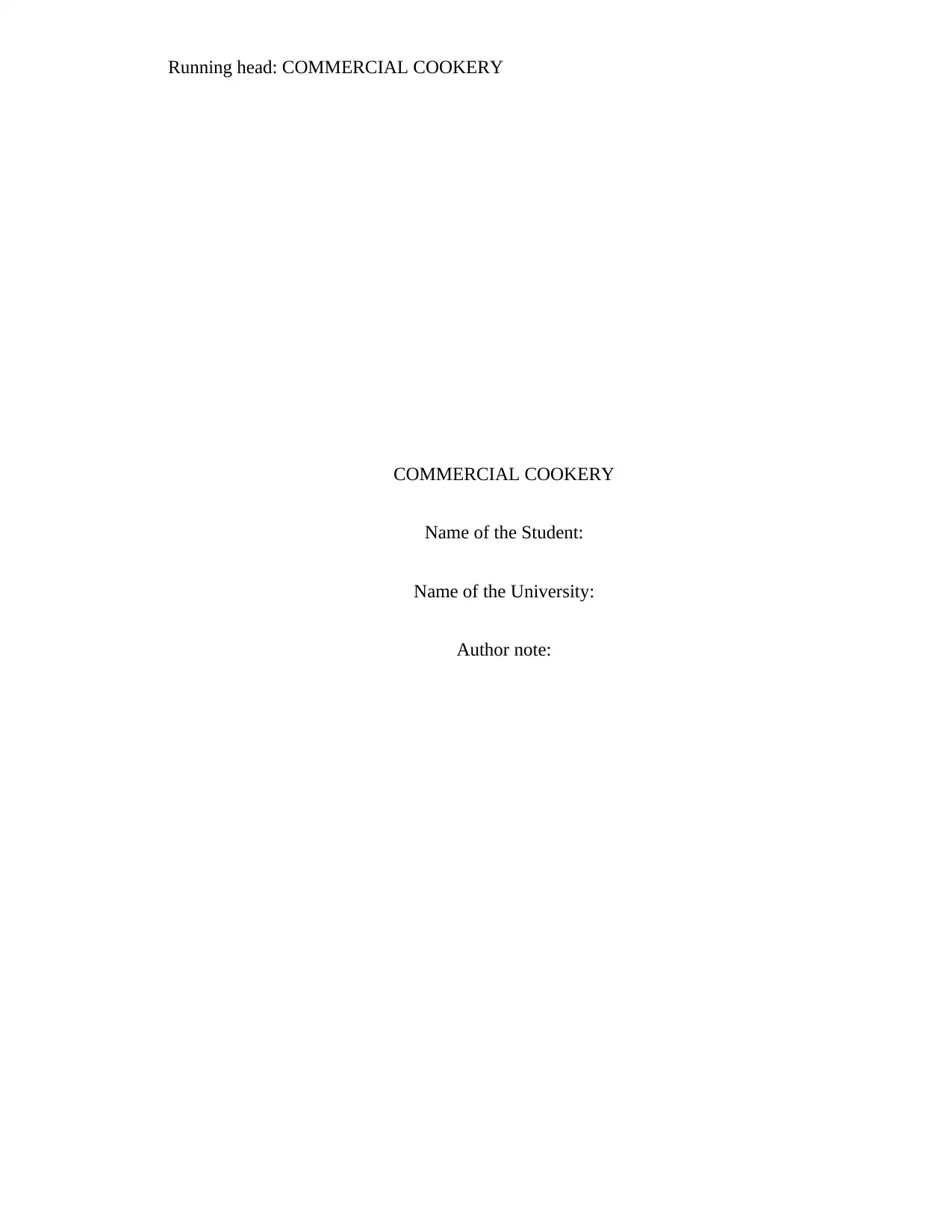
Running head: COMMERCIAL COOKERY
COMMERCIAL COOKERY
Name of the Student:
Name of the University:
Author note:
COMMERCIAL COOKERY
Name of the Student:
Name of the University:
Author note:
Paraphrase This Document
Need a fresh take? Get an instant paraphrase of this document with our AI Paraphraser
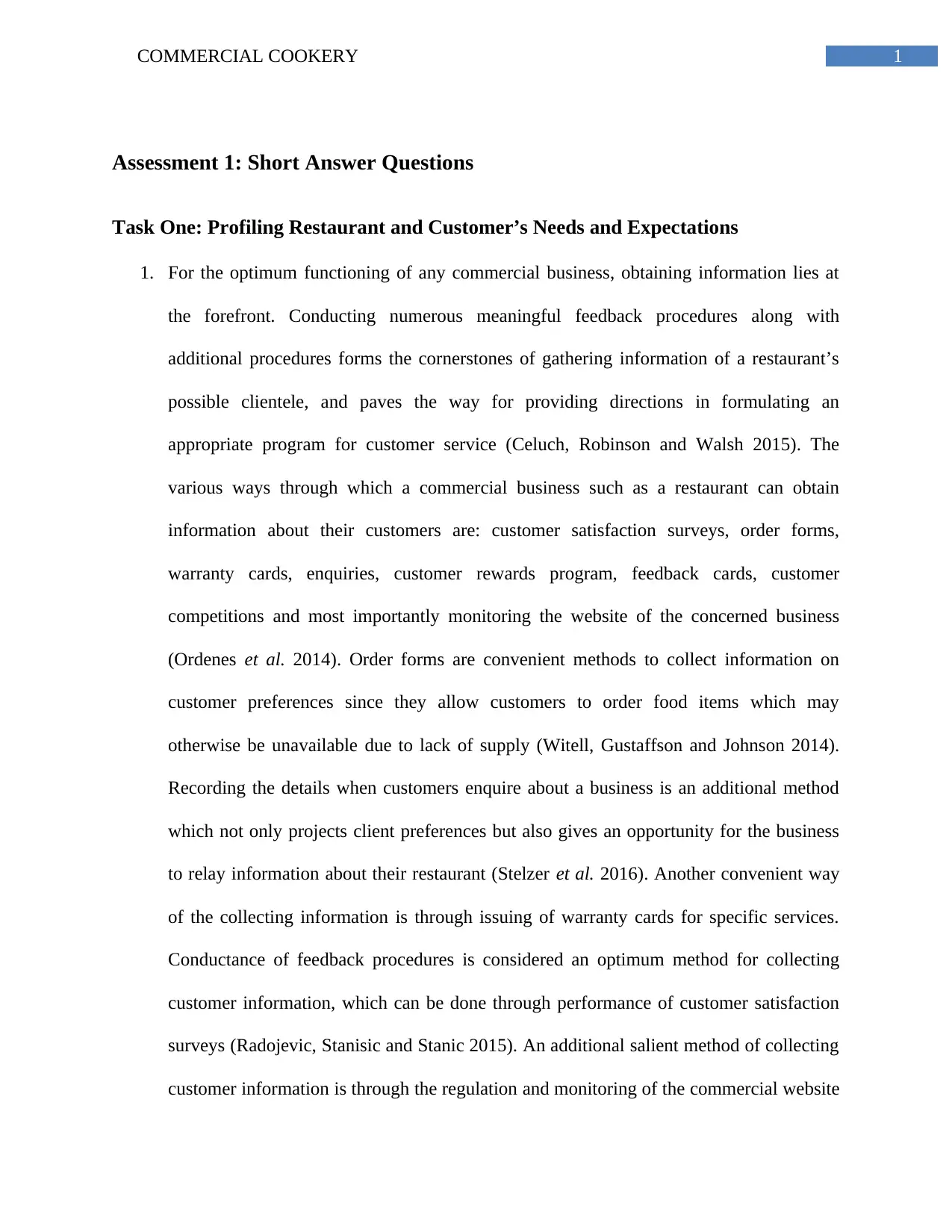
1COMMERCIAL COOKERY
Assessment 1: Short Answer Questions
Task One: Profiling Restaurant and Customer’s Needs and Expectations
1. For the optimum functioning of any commercial business, obtaining information lies at
the forefront. Conducting numerous meaningful feedback procedures along with
additional procedures forms the cornerstones of gathering information of a restaurant’s
possible clientele, and paves the way for providing directions in formulating an
appropriate program for customer service (Celuch, Robinson and Walsh 2015). The
various ways through which a commercial business such as a restaurant can obtain
information about their customers are: customer satisfaction surveys, order forms,
warranty cards, enquiries, customer rewards program, feedback cards, customer
competitions and most importantly monitoring the website of the concerned business
(Ordenes et al. 2014). Order forms are convenient methods to collect information on
customer preferences since they allow customers to order food items which may
otherwise be unavailable due to lack of supply (Witell, Gustaffson and Johnson 2014).
Recording the details when customers enquire about a business is an additional method
which not only projects client preferences but also gives an opportunity for the business
to relay information about their restaurant (Stelzer et al. 2016). Another convenient way
of the collecting information is through issuing of warranty cards for specific services.
Conductance of feedback procedures is considered an optimum method for collecting
customer information, which can be done through performance of customer satisfaction
surveys (Radojevic, Stanisic and Stanic 2015). An additional salient method of collecting
customer information is through the regulation and monitoring of the commercial website
Assessment 1: Short Answer Questions
Task One: Profiling Restaurant and Customer’s Needs and Expectations
1. For the optimum functioning of any commercial business, obtaining information lies at
the forefront. Conducting numerous meaningful feedback procedures along with
additional procedures forms the cornerstones of gathering information of a restaurant’s
possible clientele, and paves the way for providing directions in formulating an
appropriate program for customer service (Celuch, Robinson and Walsh 2015). The
various ways through which a commercial business such as a restaurant can obtain
information about their customers are: customer satisfaction surveys, order forms,
warranty cards, enquiries, customer rewards program, feedback cards, customer
competitions and most importantly monitoring the website of the concerned business
(Ordenes et al. 2014). Order forms are convenient methods to collect information on
customer preferences since they allow customers to order food items which may
otherwise be unavailable due to lack of supply (Witell, Gustaffson and Johnson 2014).
Recording the details when customers enquire about a business is an additional method
which not only projects client preferences but also gives an opportunity for the business
to relay information about their restaurant (Stelzer et al. 2016). Another convenient way
of the collecting information is through issuing of warranty cards for specific services.
Conductance of feedback procedures is considered an optimum method for collecting
customer information, which can be done through performance of customer satisfaction
surveys (Radojevic, Stanisic and Stanic 2015). An additional salient method of collecting
customer information is through the regulation and monitoring of the commercial website
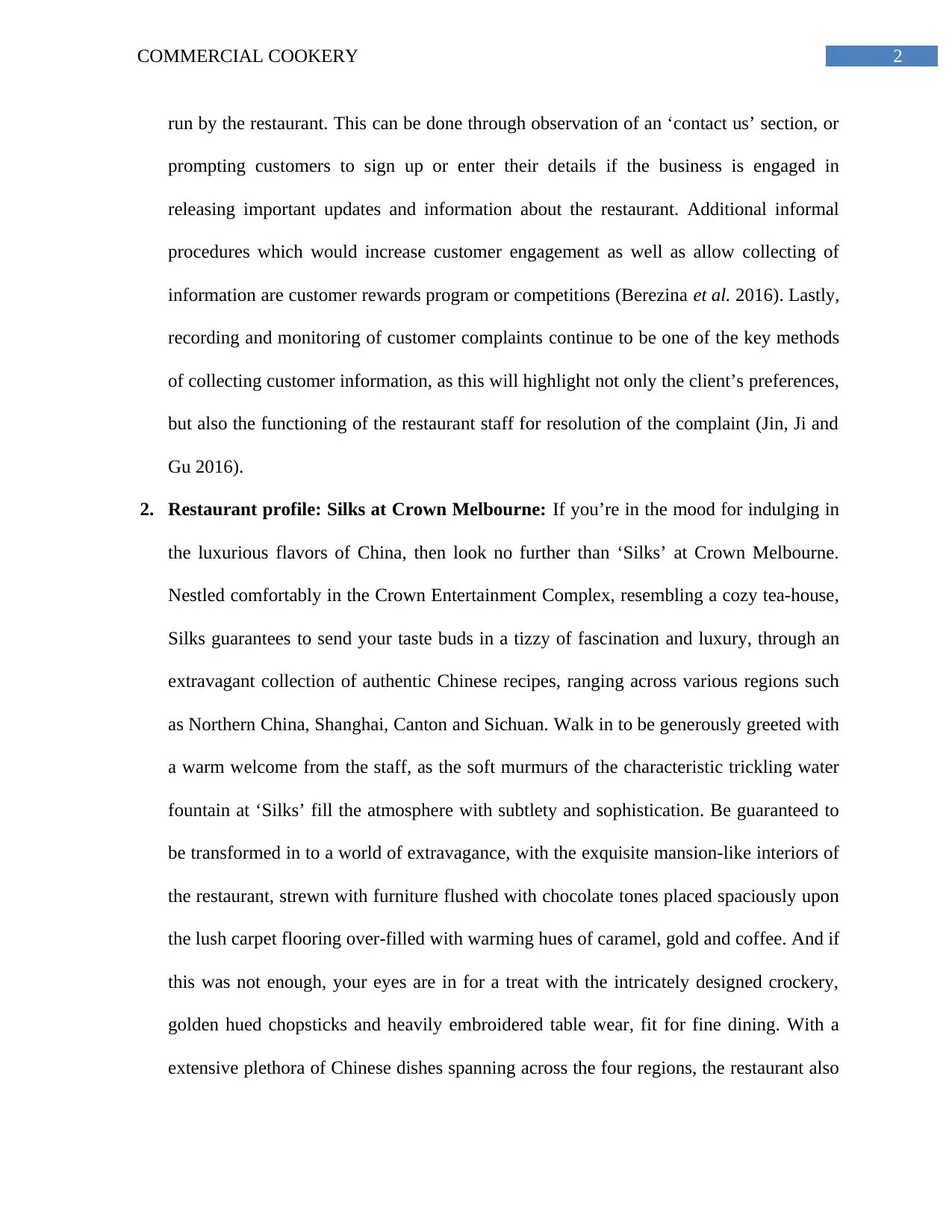
2COMMERCIAL COOKERY
run by the restaurant. This can be done through observation of an ‘contact us’ section, or
prompting customers to sign up or enter their details if the business is engaged in
releasing important updates and information about the restaurant. Additional informal
procedures which would increase customer engagement as well as allow collecting of
information are customer rewards program or competitions (Berezina et al. 2016). Lastly,
recording and monitoring of customer complaints continue to be one of the key methods
of collecting customer information, as this will highlight not only the client’s preferences,
but also the functioning of the restaurant staff for resolution of the complaint (Jin, Ji and
Gu 2016).
2. Restaurant profile: Silks at Crown Melbourne: If you’re in the mood for indulging in
the luxurious flavors of China, then look no further than ‘Silks’ at Crown Melbourne.
Nestled comfortably in the Crown Entertainment Complex, resembling a cozy tea-house,
Silks guarantees to send your taste buds in a tizzy of fascination and luxury, through an
extravagant collection of authentic Chinese recipes, ranging across various regions such
as Northern China, Shanghai, Canton and Sichuan. Walk in to be generously greeted with
a warm welcome from the staff, as the soft murmurs of the characteristic trickling water
fountain at ‘Silks’ fill the atmosphere with subtlety and sophistication. Be guaranteed to
be transformed in to a world of extravagance, with the exquisite mansion-like interiors of
the restaurant, strewn with furniture flushed with chocolate tones placed spaciously upon
the lush carpet flooring over-filled with warming hues of caramel, gold and coffee. And if
this was not enough, your eyes are in for a treat with the intricately designed crockery,
golden hued chopsticks and heavily embroidered table wear, fit for fine dining. With a
extensive plethora of Chinese dishes spanning across the four regions, the restaurant also
run by the restaurant. This can be done through observation of an ‘contact us’ section, or
prompting customers to sign up or enter their details if the business is engaged in
releasing important updates and information about the restaurant. Additional informal
procedures which would increase customer engagement as well as allow collecting of
information are customer rewards program or competitions (Berezina et al. 2016). Lastly,
recording and monitoring of customer complaints continue to be one of the key methods
of collecting customer information, as this will highlight not only the client’s preferences,
but also the functioning of the restaurant staff for resolution of the complaint (Jin, Ji and
Gu 2016).
2. Restaurant profile: Silks at Crown Melbourne: If you’re in the mood for indulging in
the luxurious flavors of China, then look no further than ‘Silks’ at Crown Melbourne.
Nestled comfortably in the Crown Entertainment Complex, resembling a cozy tea-house,
Silks guarantees to send your taste buds in a tizzy of fascination and luxury, through an
extravagant collection of authentic Chinese recipes, ranging across various regions such
as Northern China, Shanghai, Canton and Sichuan. Walk in to be generously greeted with
a warm welcome from the staff, as the soft murmurs of the characteristic trickling water
fountain at ‘Silks’ fill the atmosphere with subtlety and sophistication. Be guaranteed to
be transformed in to a world of extravagance, with the exquisite mansion-like interiors of
the restaurant, strewn with furniture flushed with chocolate tones placed spaciously upon
the lush carpet flooring over-filled with warming hues of caramel, gold and coffee. And if
this was not enough, your eyes are in for a treat with the intricately designed crockery,
golden hued chopsticks and heavily embroidered table wear, fit for fine dining. With a
extensive plethora of Chinese dishes spanning across the four regions, the restaurant also
⊘ This is a preview!⊘
Do you want full access?
Subscribe today to unlock all pages.

Trusted by 1+ million students worldwide
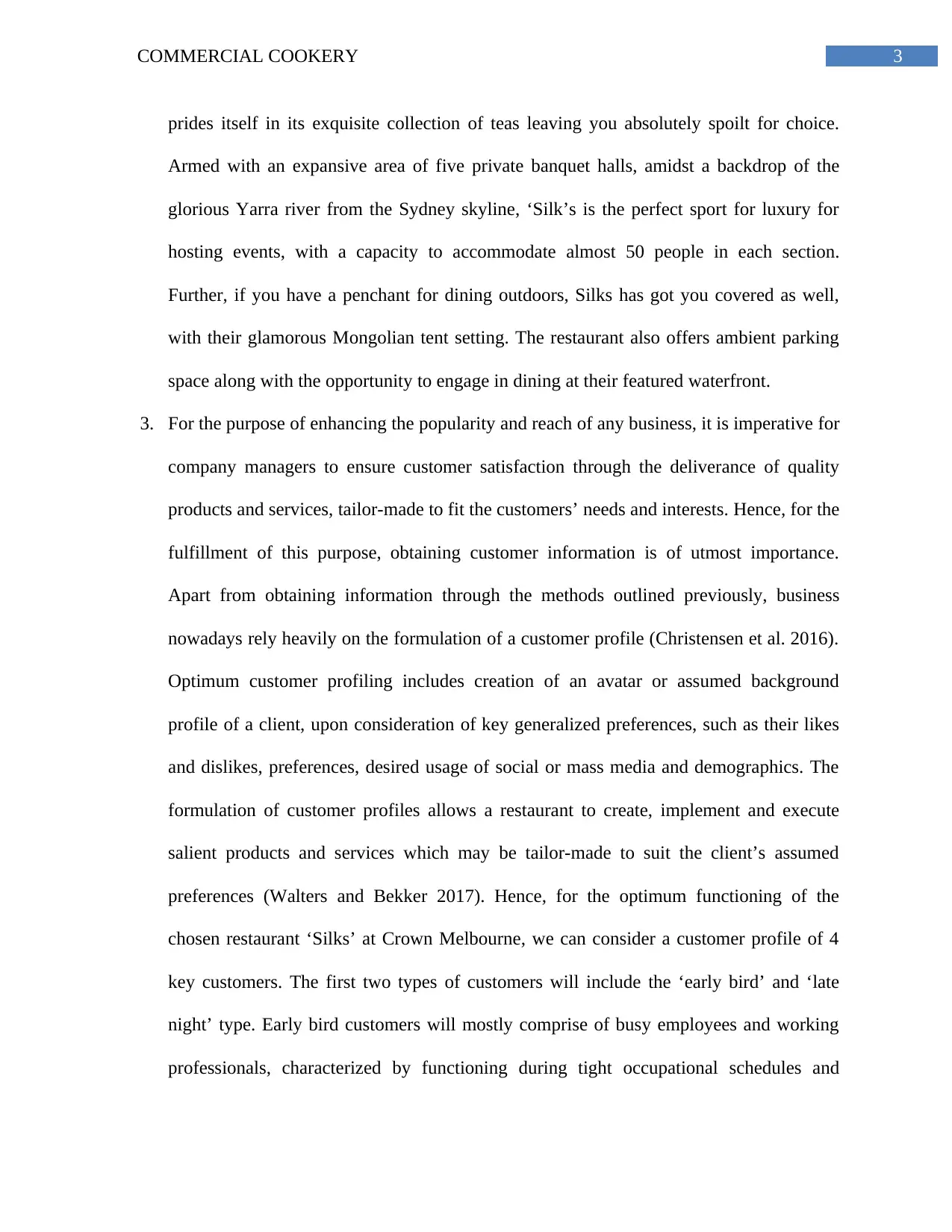
3COMMERCIAL COOKERY
prides itself in its exquisite collection of teas leaving you absolutely spoilt for choice.
Armed with an expansive area of five private banquet halls, amidst a backdrop of the
glorious Yarra river from the Sydney skyline, ‘Silk’s is the perfect sport for luxury for
hosting events, with a capacity to accommodate almost 50 people in each section.
Further, if you have a penchant for dining outdoors, Silks has got you covered as well,
with their glamorous Mongolian tent setting. The restaurant also offers ambient parking
space along with the opportunity to engage in dining at their featured waterfront.
3. For the purpose of enhancing the popularity and reach of any business, it is imperative for
company managers to ensure customer satisfaction through the deliverance of quality
products and services, tailor-made to fit the customers’ needs and interests. Hence, for the
fulfillment of this purpose, obtaining customer information is of utmost importance.
Apart from obtaining information through the methods outlined previously, business
nowadays rely heavily on the formulation of a customer profile (Christensen et al. 2016).
Optimum customer profiling includes creation of an avatar or assumed background
profile of a client, upon consideration of key generalized preferences, such as their likes
and dislikes, preferences, desired usage of social or mass media and demographics. The
formulation of customer profiles allows a restaurant to create, implement and execute
salient products and services which may be tailor-made to suit the client’s assumed
preferences (Walters and Bekker 2017). Hence, for the optimum functioning of the
chosen restaurant ‘Silks’ at Crown Melbourne, we can consider a customer profile of 4
key customers. The first two types of customers will include the ‘early bird’ and ‘late
night’ type. Early bird customers will mostly comprise of busy employees and working
professionals, characterized by functioning during tight occupational schedules and
prides itself in its exquisite collection of teas leaving you absolutely spoilt for choice.
Armed with an expansive area of five private banquet halls, amidst a backdrop of the
glorious Yarra river from the Sydney skyline, ‘Silk’s is the perfect sport for luxury for
hosting events, with a capacity to accommodate almost 50 people in each section.
Further, if you have a penchant for dining outdoors, Silks has got you covered as well,
with their glamorous Mongolian tent setting. The restaurant also offers ambient parking
space along with the opportunity to engage in dining at their featured waterfront.
3. For the purpose of enhancing the popularity and reach of any business, it is imperative for
company managers to ensure customer satisfaction through the deliverance of quality
products and services, tailor-made to fit the customers’ needs and interests. Hence, for the
fulfillment of this purpose, obtaining customer information is of utmost importance.
Apart from obtaining information through the methods outlined previously, business
nowadays rely heavily on the formulation of a customer profile (Christensen et al. 2016).
Optimum customer profiling includes creation of an avatar or assumed background
profile of a client, upon consideration of key generalized preferences, such as their likes
and dislikes, preferences, desired usage of social or mass media and demographics. The
formulation of customer profiles allows a restaurant to create, implement and execute
salient products and services which may be tailor-made to suit the client’s assumed
preferences (Walters and Bekker 2017). Hence, for the optimum functioning of the
chosen restaurant ‘Silks’ at Crown Melbourne, we can consider a customer profile of 4
key customers. The first two types of customers will include the ‘early bird’ and ‘late
night’ type. Early bird customers will mostly comprise of busy employees and working
professionals, characterized by functioning during tight occupational schedules and
Paraphrase This Document
Need a fresh take? Get an instant paraphrase of this document with our AI Paraphraser
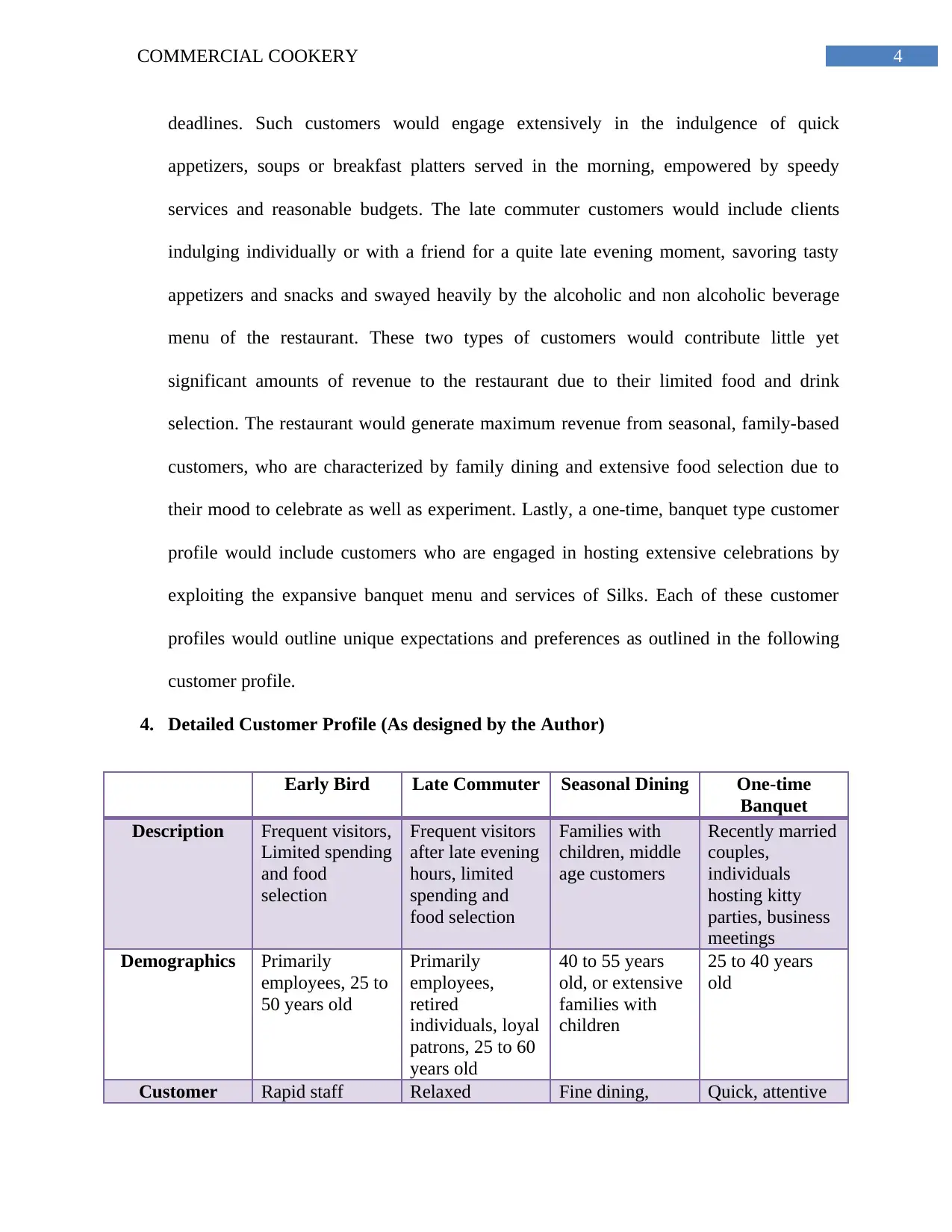
4COMMERCIAL COOKERY
deadlines. Such customers would engage extensively in the indulgence of quick
appetizers, soups or breakfast platters served in the morning, empowered by speedy
services and reasonable budgets. The late commuter customers would include clients
indulging individually or with a friend for a quite late evening moment, savoring tasty
appetizers and snacks and swayed heavily by the alcoholic and non alcoholic beverage
menu of the restaurant. These two types of customers would contribute little yet
significant amounts of revenue to the restaurant due to their limited food and drink
selection. The restaurant would generate maximum revenue from seasonal, family-based
customers, who are characterized by family dining and extensive food selection due to
their mood to celebrate as well as experiment. Lastly, a one-time, banquet type customer
profile would include customers who are engaged in hosting extensive celebrations by
exploiting the expansive banquet menu and services of Silks. Each of these customer
profiles would outline unique expectations and preferences as outlined in the following
customer profile.
4. Detailed Customer Profile (As designed by the Author)
Early Bird Late Commuter Seasonal Dining One-time
Banquet
Description Frequent visitors,
Limited spending
and food
selection
Frequent visitors
after late evening
hours, limited
spending and
food selection
Families with
children, middle
age customers
Recently married
couples,
individuals
hosting kitty
parties, business
meetings
Demographics Primarily
employees, 25 to
50 years old
Primarily
employees,
retired
individuals, loyal
patrons, 25 to 60
years old
40 to 55 years
old, or extensive
families with
children
25 to 40 years
old
Customer Rapid staff Relaxed Fine dining, Quick, attentive
deadlines. Such customers would engage extensively in the indulgence of quick
appetizers, soups or breakfast platters served in the morning, empowered by speedy
services and reasonable budgets. The late commuter customers would include clients
indulging individually or with a friend for a quite late evening moment, savoring tasty
appetizers and snacks and swayed heavily by the alcoholic and non alcoholic beverage
menu of the restaurant. These two types of customers would contribute little yet
significant amounts of revenue to the restaurant due to their limited food and drink
selection. The restaurant would generate maximum revenue from seasonal, family-based
customers, who are characterized by family dining and extensive food selection due to
their mood to celebrate as well as experiment. Lastly, a one-time, banquet type customer
profile would include customers who are engaged in hosting extensive celebrations by
exploiting the expansive banquet menu and services of Silks. Each of these customer
profiles would outline unique expectations and preferences as outlined in the following
customer profile.
4. Detailed Customer Profile (As designed by the Author)
Early Bird Late Commuter Seasonal Dining One-time
Banquet
Description Frequent visitors,
Limited spending
and food
selection
Frequent visitors
after late evening
hours, limited
spending and
food selection
Families with
children, middle
age customers
Recently married
couples,
individuals
hosting kitty
parties, business
meetings
Demographics Primarily
employees, 25 to
50 years old
Primarily
employees,
retired
individuals, loyal
patrons, 25 to 60
years old
40 to 55 years
old, or extensive
families with
children
25 to 40 years
old
Customer Rapid staff Relaxed Fine dining, Quick, attentive
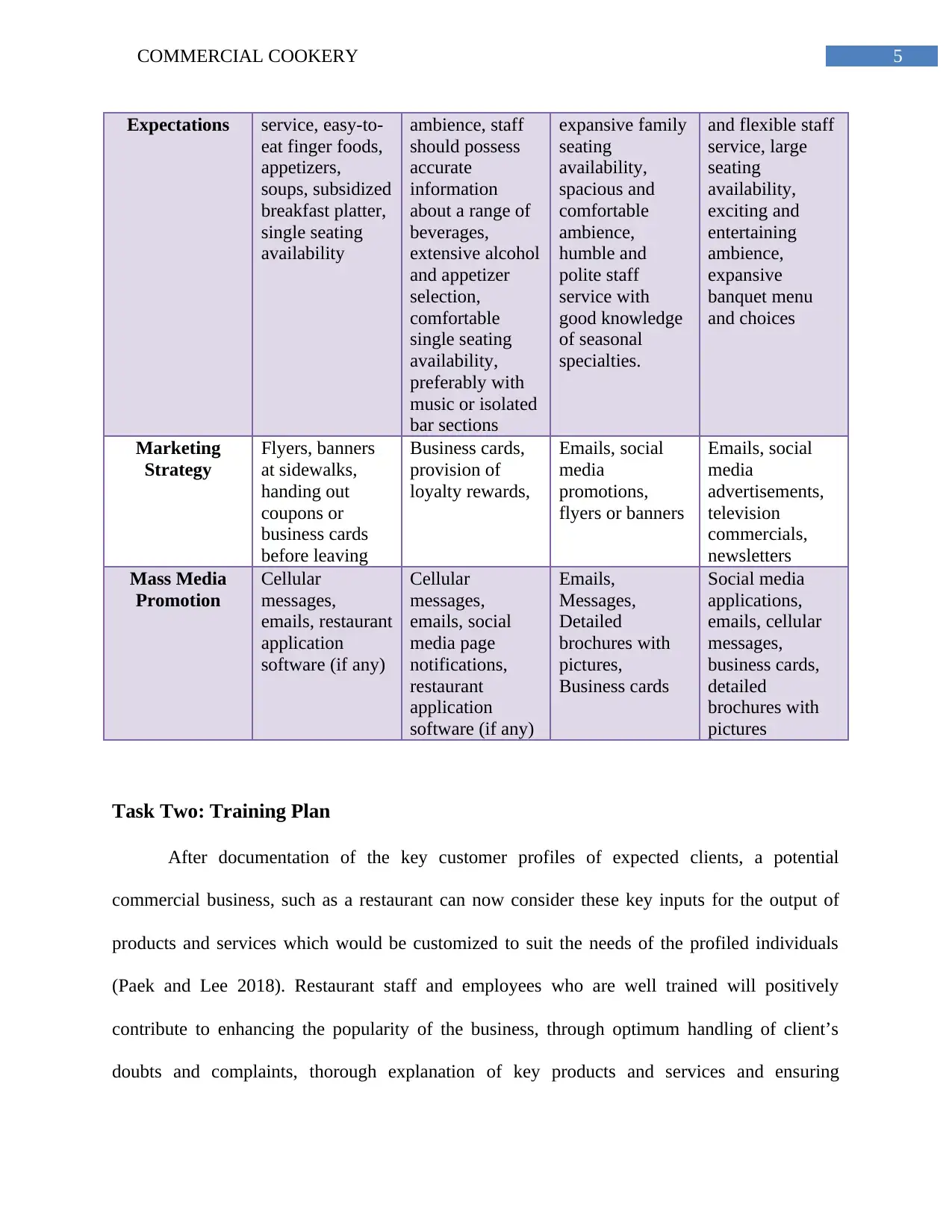
5COMMERCIAL COOKERY
Expectations service, easy-to-
eat finger foods,
appetizers,
soups, subsidized
breakfast platter,
single seating
availability
ambience, staff
should possess
accurate
information
about a range of
beverages,
extensive alcohol
and appetizer
selection,
comfortable
single seating
availability,
preferably with
music or isolated
bar sections
expansive family
seating
availability,
spacious and
comfortable
ambience,
humble and
polite staff
service with
good knowledge
of seasonal
specialties.
and flexible staff
service, large
seating
availability,
exciting and
entertaining
ambience,
expansive
banquet menu
and choices
Marketing
Strategy
Flyers, banners
at sidewalks,
handing out
coupons or
business cards
before leaving
Business cards,
provision of
loyalty rewards,
Emails, social
media
promotions,
flyers or banners
Emails, social
media
advertisements,
television
commercials,
newsletters
Mass Media
Promotion
Cellular
messages,
emails, restaurant
application
software (if any)
Cellular
messages,
emails, social
media page
notifications,
restaurant
application
software (if any)
Emails,
Messages,
Detailed
brochures with
pictures,
Business cards
Social media
applications,
emails, cellular
messages,
business cards,
detailed
brochures with
pictures
Task Two: Training Plan
After documentation of the key customer profiles of expected clients, a potential
commercial business, such as a restaurant can now consider these key inputs for the output of
products and services which would be customized to suit the needs of the profiled individuals
(Paek and Lee 2018). Restaurant staff and employees who are well trained will positively
contribute to enhancing the popularity of the business, through optimum handling of client’s
doubts and complaints, thorough explanation of key products and services and ensuring
Expectations service, easy-to-
eat finger foods,
appetizers,
soups, subsidized
breakfast platter,
single seating
availability
ambience, staff
should possess
accurate
information
about a range of
beverages,
extensive alcohol
and appetizer
selection,
comfortable
single seating
availability,
preferably with
music or isolated
bar sections
expansive family
seating
availability,
spacious and
comfortable
ambience,
humble and
polite staff
service with
good knowledge
of seasonal
specialties.
and flexible staff
service, large
seating
availability,
exciting and
entertaining
ambience,
expansive
banquet menu
and choices
Marketing
Strategy
Flyers, banners
at sidewalks,
handing out
coupons or
business cards
before leaving
Business cards,
provision of
loyalty rewards,
Emails, social
media
promotions,
flyers or banners
Emails, social
media
advertisements,
television
commercials,
newsletters
Mass Media
Promotion
Cellular
messages,
emails, restaurant
application
software (if any)
Cellular
messages,
emails, social
media page
notifications,
restaurant
application
software (if any)
Emails,
Messages,
Detailed
brochures with
pictures,
Business cards
Social media
applications,
emails, cellular
messages,
business cards,
detailed
brochures with
pictures
Task Two: Training Plan
After documentation of the key customer profiles of expected clients, a potential
commercial business, such as a restaurant can now consider these key inputs for the output of
products and services which would be customized to suit the needs of the profiled individuals
(Paek and Lee 2018). Restaurant staff and employees who are well trained will positively
contribute to enhancing the popularity of the business, through optimum handling of client’s
doubts and complaints, thorough explanation of key products and services and ensuring
⊘ This is a preview!⊘
Do you want full access?
Subscribe today to unlock all pages.

Trusted by 1+ million students worldwide
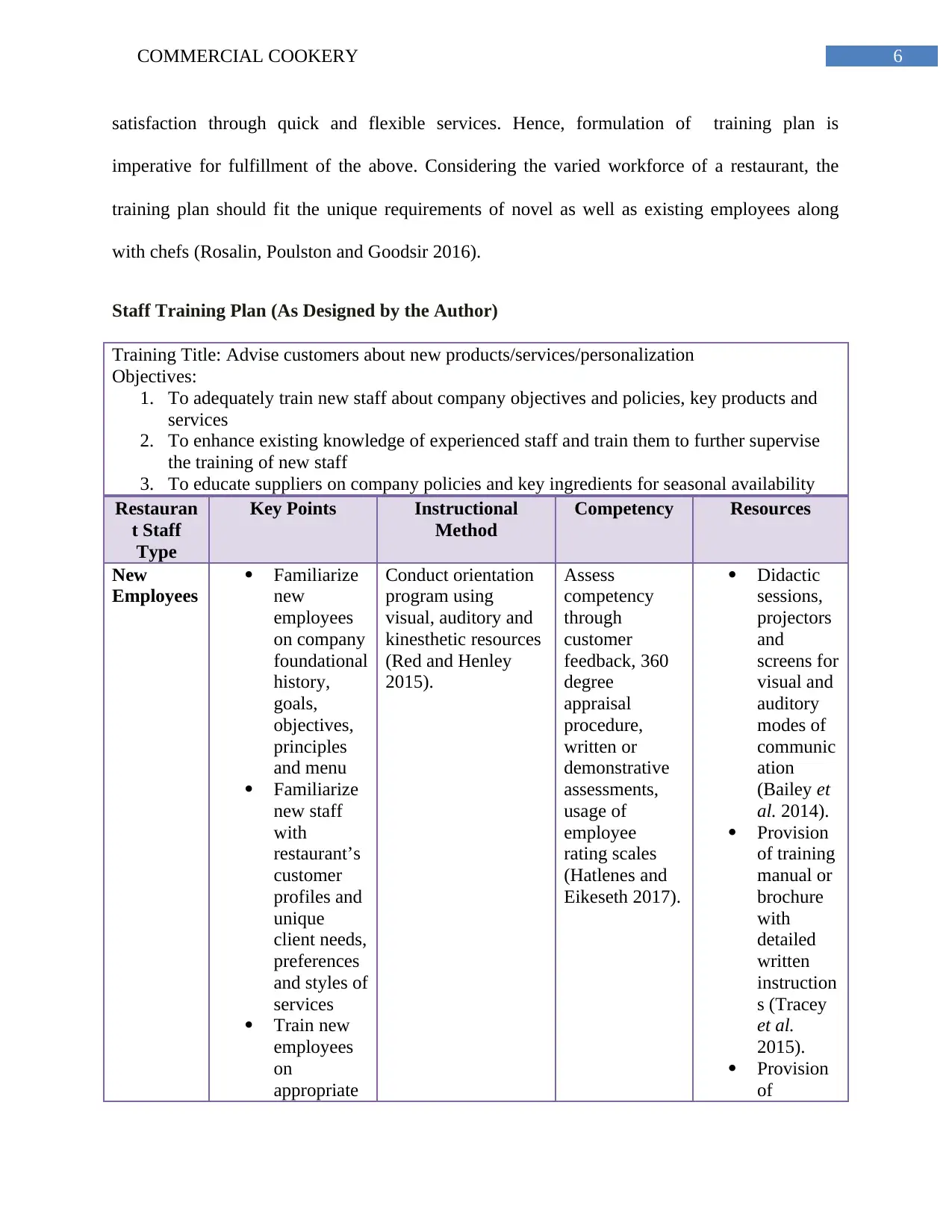
6COMMERCIAL COOKERY
satisfaction through quick and flexible services. Hence, formulation of training plan is
imperative for fulfillment of the above. Considering the varied workforce of a restaurant, the
training plan should fit the unique requirements of novel as well as existing employees along
with chefs (Rosalin, Poulston and Goodsir 2016).
Staff Training Plan (As Designed by the Author)
Training Title: Advise customers about new products/services/personalization
Objectives:
1. To adequately train new staff about company objectives and policies, key products and
services
2. To enhance existing knowledge of experienced staff and train them to further supervise
the training of new staff
3. To educate suppliers on company policies and key ingredients for seasonal availability
Restauran
t Staff
Type
Key Points Instructional
Method
Competency Resources
New
Employees
Familiarize
new
employees
on company
foundational
history,
goals,
objectives,
principles
and menu
Familiarize
new staff
with
restaurant’s
customer
profiles and
unique
client needs,
preferences
and styles of
services
Train new
employees
on
appropriate
Conduct orientation
program using
visual, auditory and
kinesthetic resources
(Red and Henley
2015).
Assess
competency
through
customer
feedback, 360
degree
appraisal
procedure,
written or
demonstrative
assessments,
usage of
employee
rating scales
(Hatlenes and
Eikeseth 2017).
Didactic
sessions,
projectors
and
screens for
visual and
auditory
modes of
communic
ation
(Bailey et
al. 2014).
Provision
of training
manual or
brochure
with
detailed
written
instruction
s (Tracey
et al.
2015).
Provision
of
satisfaction through quick and flexible services. Hence, formulation of training plan is
imperative for fulfillment of the above. Considering the varied workforce of a restaurant, the
training plan should fit the unique requirements of novel as well as existing employees along
with chefs (Rosalin, Poulston and Goodsir 2016).
Staff Training Plan (As Designed by the Author)
Training Title: Advise customers about new products/services/personalization
Objectives:
1. To adequately train new staff about company objectives and policies, key products and
services
2. To enhance existing knowledge of experienced staff and train them to further supervise
the training of new staff
3. To educate suppliers on company policies and key ingredients for seasonal availability
Restauran
t Staff
Type
Key Points Instructional
Method
Competency Resources
New
Employees
Familiarize
new
employees
on company
foundational
history,
goals,
objectives,
principles
and menu
Familiarize
new staff
with
restaurant’s
customer
profiles and
unique
client needs,
preferences
and styles of
services
Train new
employees
on
appropriate
Conduct orientation
program using
visual, auditory and
kinesthetic resources
(Red and Henley
2015).
Assess
competency
through
customer
feedback, 360
degree
appraisal
procedure,
written or
demonstrative
assessments,
usage of
employee
rating scales
(Hatlenes and
Eikeseth 2017).
Didactic
sessions,
projectors
and
screens for
visual and
auditory
modes of
communic
ation
(Bailey et
al. 2014).
Provision
of training
manual or
brochure
with
detailed
written
instruction
s (Tracey
et al.
2015).
Provision
of
Paraphrase This Document
Need a fresh take? Get an instant paraphrase of this document with our AI Paraphraser
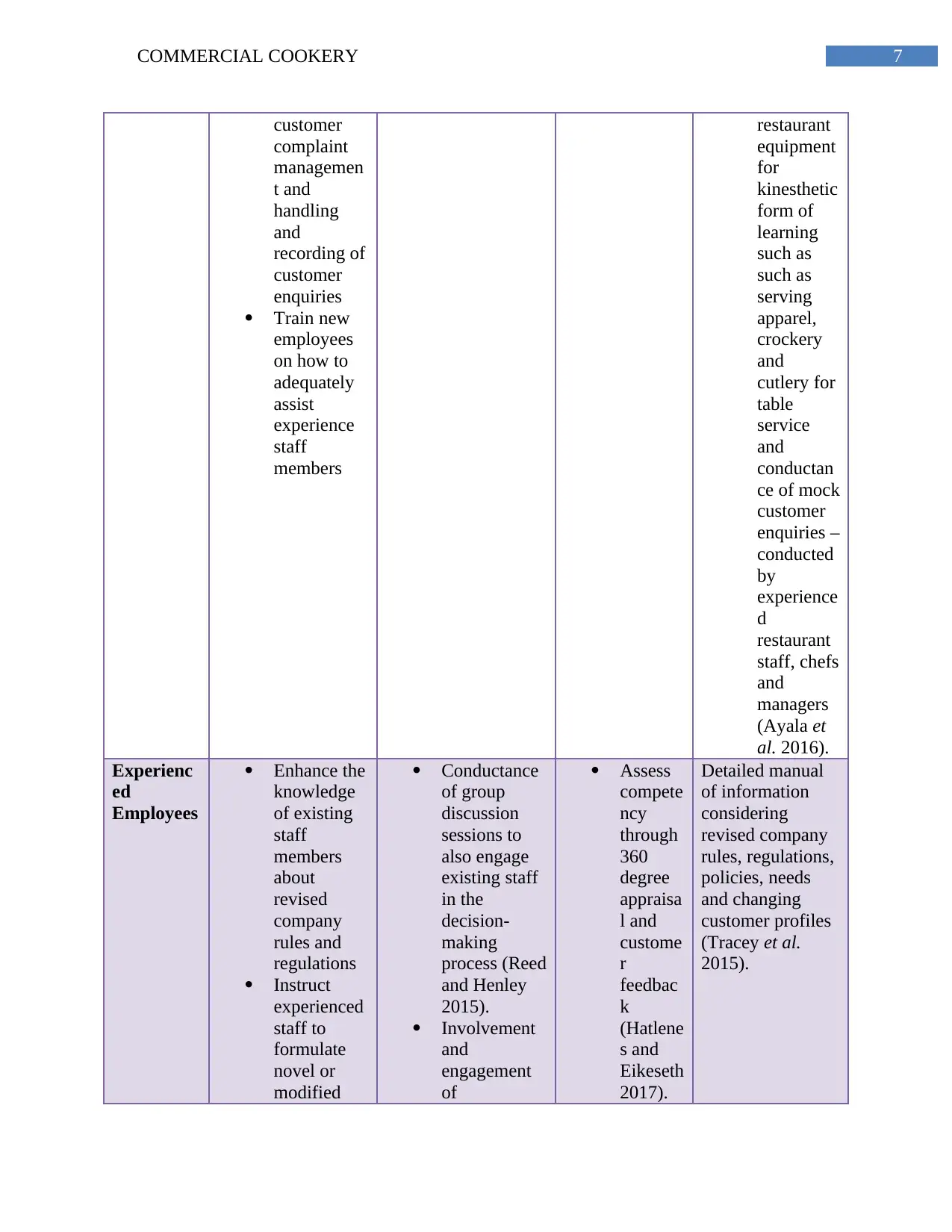
7COMMERCIAL COOKERY
customer
complaint
managemen
t and
handling
and
recording of
customer
enquiries
Train new
employees
on how to
adequately
assist
experience
staff
members
restaurant
equipment
for
kinesthetic
form of
learning
such as
such as
serving
apparel,
crockery
and
cutlery for
table
service
and
conductan
ce of mock
customer
enquiries –
conducted
by
experience
d
restaurant
staff, chefs
and
managers
(Ayala et
al. 2016).
Experienc
ed
Employees
Enhance the
knowledge
of existing
staff
members
about
revised
company
rules and
regulations
Instruct
experienced
staff to
formulate
novel or
modified
Conductance
of group
discussion
sessions to
also engage
existing staff
in the
decision-
making
process (Reed
and Henley
2015).
Involvement
and
engagement
of
Assess
compete
ncy
through
360
degree
appraisa
l and
custome
r
feedbac
k
(Hatlene
s and
Eikeseth
2017).
Detailed manual
of information
considering
revised company
rules, regulations,
policies, needs
and changing
customer profiles
(Tracey et al.
2015).
customer
complaint
managemen
t and
handling
and
recording of
customer
enquiries
Train new
employees
on how to
adequately
assist
experience
staff
members
restaurant
equipment
for
kinesthetic
form of
learning
such as
such as
serving
apparel,
crockery
and
cutlery for
table
service
and
conductan
ce of mock
customer
enquiries –
conducted
by
experience
d
restaurant
staff, chefs
and
managers
(Ayala et
al. 2016).
Experienc
ed
Employees
Enhance the
knowledge
of existing
staff
members
about
revised
company
rules and
regulations
Instruct
experienced
staff to
formulate
novel or
modified
Conductance
of group
discussion
sessions to
also engage
existing staff
in the
decision-
making
process (Reed
and Henley
2015).
Involvement
and
engagement
of
Assess
compete
ncy
through
360
degree
appraisa
l and
custome
r
feedbac
k
(Hatlene
s and
Eikeseth
2017).
Detailed manual
of information
considering
revised company
rules, regulations,
policies, needs
and changing
customer profiles
(Tracey et al.
2015).
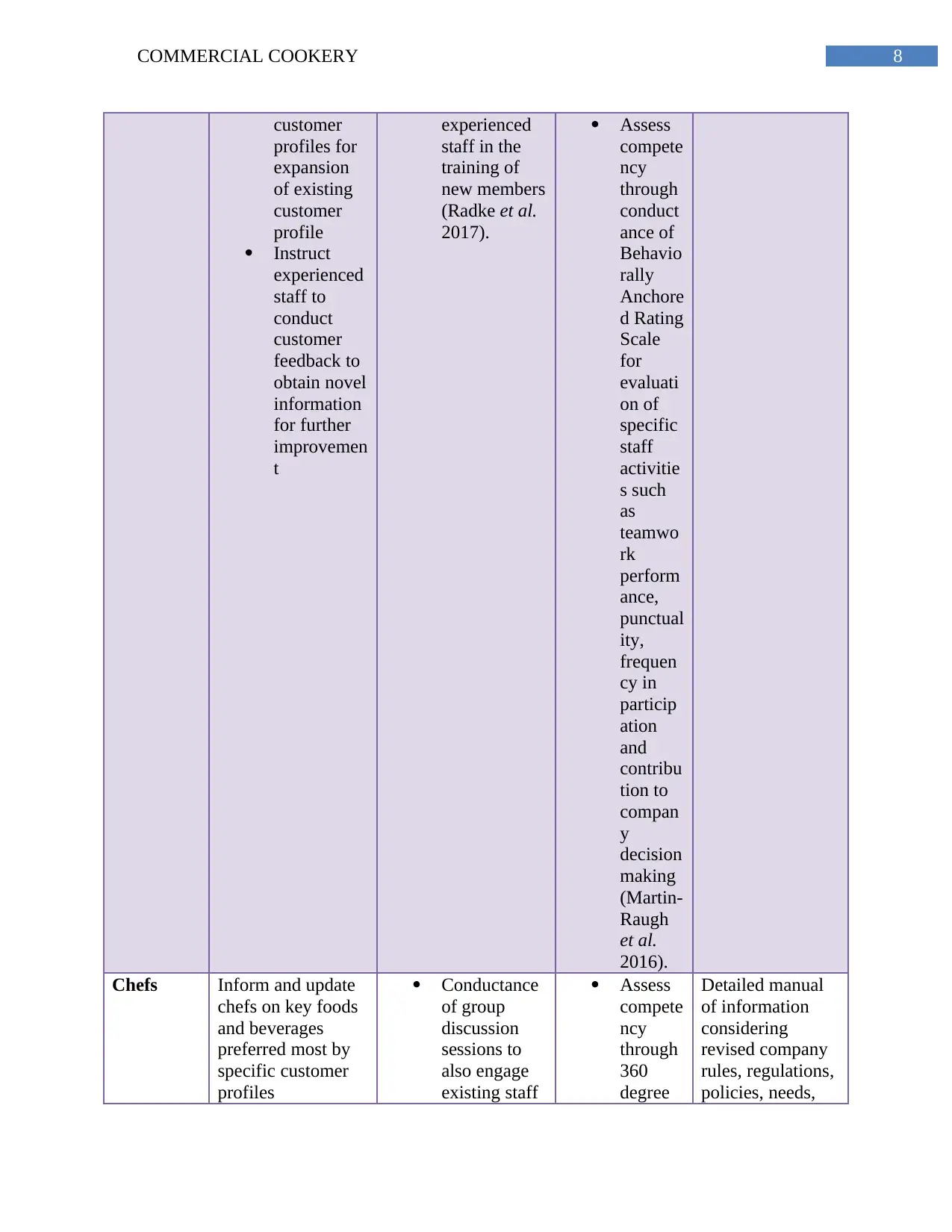
8COMMERCIAL COOKERY
customer
profiles for
expansion
of existing
customer
profile
Instruct
experienced
staff to
conduct
customer
feedback to
obtain novel
information
for further
improvemen
t
experienced
staff in the
training of
new members
(Radke et al.
2017).
Assess
compete
ncy
through
conduct
ance of
Behavio
rally
Anchore
d Rating
Scale
for
evaluati
on of
specific
staff
activitie
s such
as
teamwo
rk
perform
ance,
punctual
ity,
frequen
cy in
particip
ation
and
contribu
tion to
compan
y
decision
making
(Martin-
Raugh
et al.
2016).
Chefs Inform and update
chefs on key foods
and beverages
preferred most by
specific customer
profiles
Conductance
of group
discussion
sessions to
also engage
existing staff
Assess
compete
ncy
through
360
degree
Detailed manual
of information
considering
revised company
rules, regulations,
policies, needs,
customer
profiles for
expansion
of existing
customer
profile
Instruct
experienced
staff to
conduct
customer
feedback to
obtain novel
information
for further
improvemen
t
experienced
staff in the
training of
new members
(Radke et al.
2017).
Assess
compete
ncy
through
conduct
ance of
Behavio
rally
Anchore
d Rating
Scale
for
evaluati
on of
specific
staff
activitie
s such
as
teamwo
rk
perform
ance,
punctual
ity,
frequen
cy in
particip
ation
and
contribu
tion to
compan
y
decision
making
(Martin-
Raugh
et al.
2016).
Chefs Inform and update
chefs on key foods
and beverages
preferred most by
specific customer
profiles
Conductance
of group
discussion
sessions to
also engage
existing staff
Assess
compete
ncy
through
360
degree
Detailed manual
of information
considering
revised company
rules, regulations,
policies, needs,
⊘ This is a preview!⊘
Do you want full access?
Subscribe today to unlock all pages.

Trusted by 1+ million students worldwide
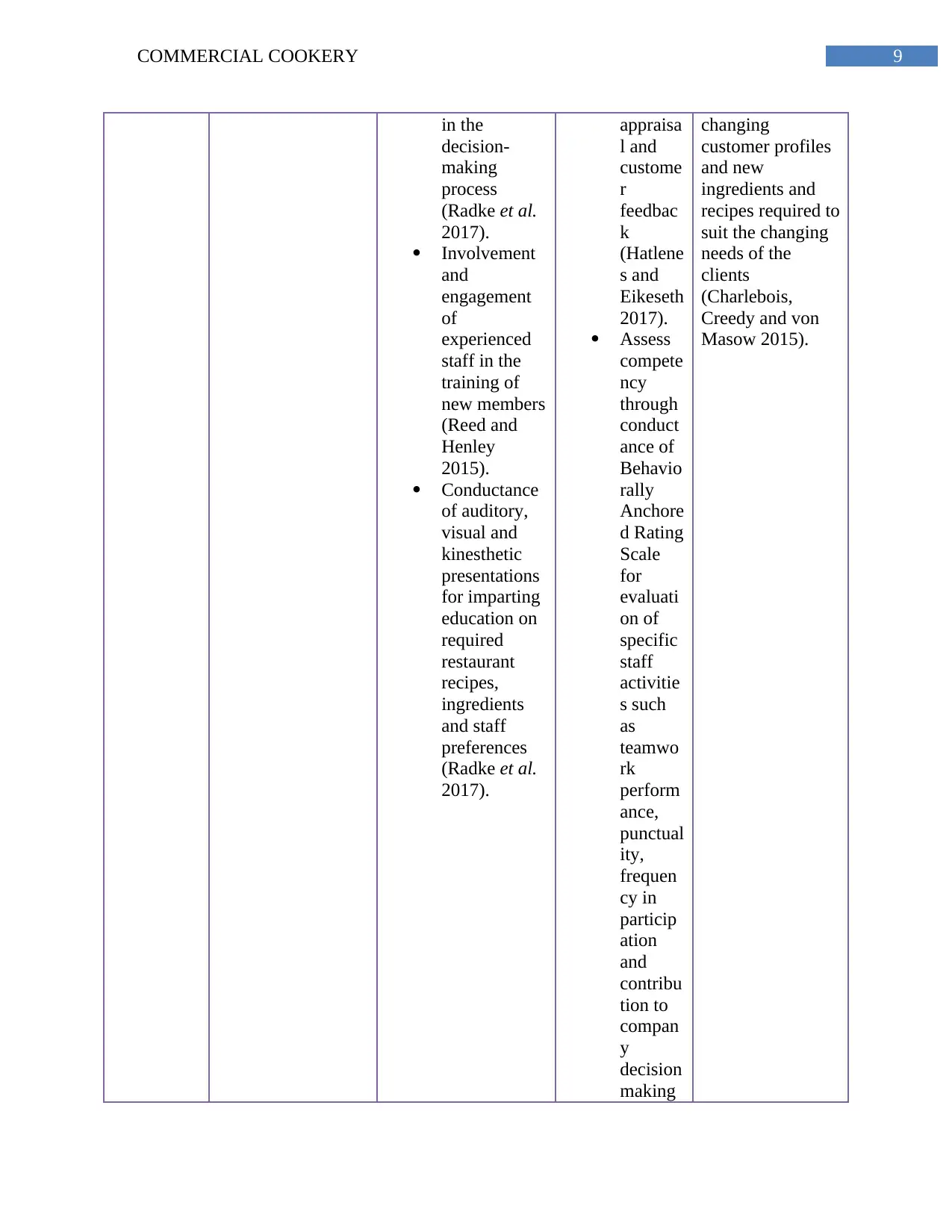
9COMMERCIAL COOKERY
in the
decision-
making
process
(Radke et al.
2017).
Involvement
and
engagement
of
experienced
staff in the
training of
new members
(Reed and
Henley
2015).
Conductance
of auditory,
visual and
kinesthetic
presentations
for imparting
education on
required
restaurant
recipes,
ingredients
and staff
preferences
(Radke et al.
2017).
appraisa
l and
custome
r
feedbac
k
(Hatlene
s and
Eikeseth
2017).
Assess
compete
ncy
through
conduct
ance of
Behavio
rally
Anchore
d Rating
Scale
for
evaluati
on of
specific
staff
activitie
s such
as
teamwo
rk
perform
ance,
punctual
ity,
frequen
cy in
particip
ation
and
contribu
tion to
compan
y
decision
making
changing
customer profiles
and new
ingredients and
recipes required to
suit the changing
needs of the
clients
(Charlebois,
Creedy and von
Masow 2015).
in the
decision-
making
process
(Radke et al.
2017).
Involvement
and
engagement
of
experienced
staff in the
training of
new members
(Reed and
Henley
2015).
Conductance
of auditory,
visual and
kinesthetic
presentations
for imparting
education on
required
restaurant
recipes,
ingredients
and staff
preferences
(Radke et al.
2017).
appraisa
l and
custome
r
feedbac
k
(Hatlene
s and
Eikeseth
2017).
Assess
compete
ncy
through
conduct
ance of
Behavio
rally
Anchore
d Rating
Scale
for
evaluati
on of
specific
staff
activitie
s such
as
teamwo
rk
perform
ance,
punctual
ity,
frequen
cy in
particip
ation
and
contribu
tion to
compan
y
decision
making
changing
customer profiles
and new
ingredients and
recipes required to
suit the changing
needs of the
clients
(Charlebois,
Creedy and von
Masow 2015).
Paraphrase This Document
Need a fresh take? Get an instant paraphrase of this document with our AI Paraphraser
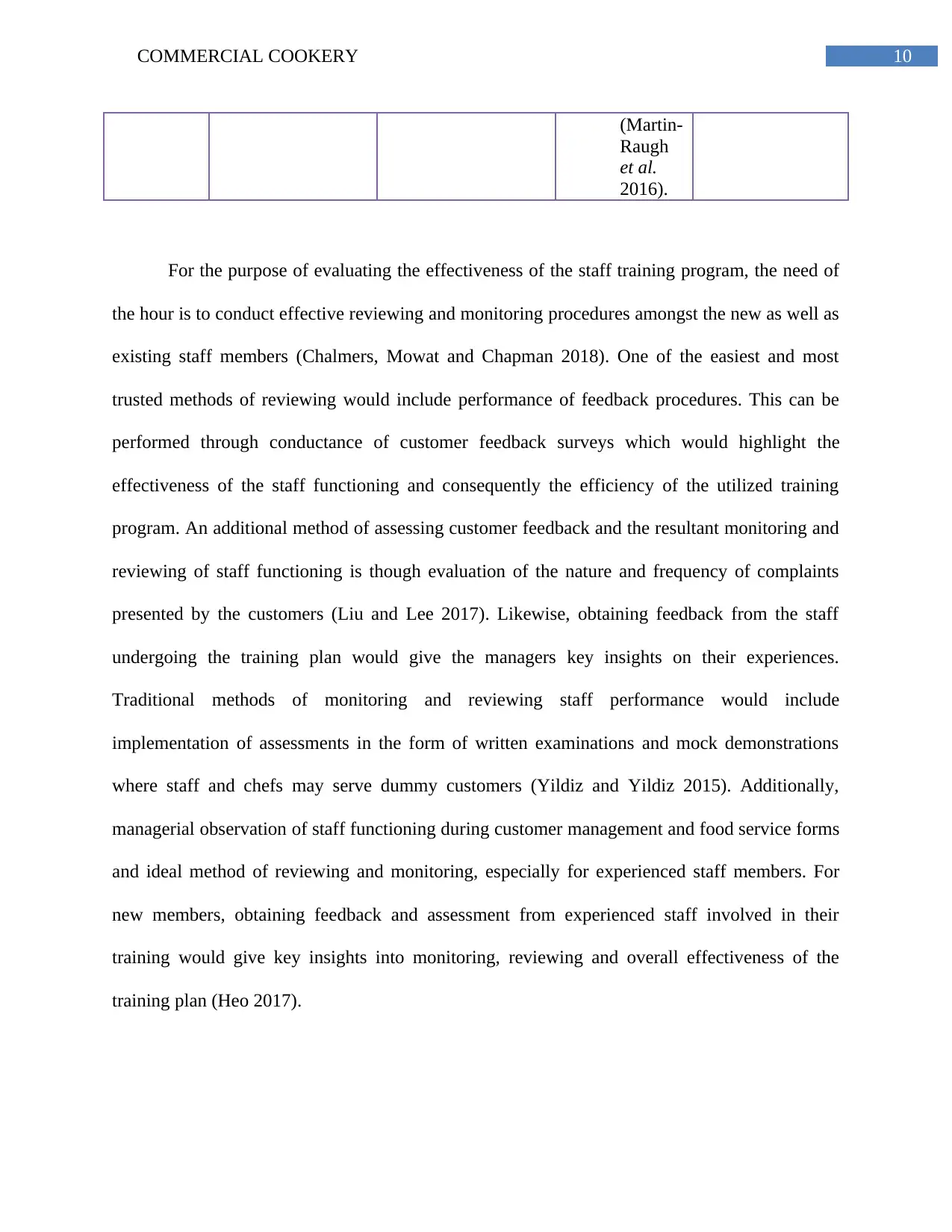
10COMMERCIAL COOKERY
(Martin-
Raugh
et al.
2016).
For the purpose of evaluating the effectiveness of the staff training program, the need of
the hour is to conduct effective reviewing and monitoring procedures amongst the new as well as
existing staff members (Chalmers, Mowat and Chapman 2018). One of the easiest and most
trusted methods of reviewing would include performance of feedback procedures. This can be
performed through conductance of customer feedback surveys which would highlight the
effectiveness of the staff functioning and consequently the efficiency of the utilized training
program. An additional method of assessing customer feedback and the resultant monitoring and
reviewing of staff functioning is though evaluation of the nature and frequency of complaints
presented by the customers (Liu and Lee 2017). Likewise, obtaining feedback from the staff
undergoing the training plan would give the managers key insights on their experiences.
Traditional methods of monitoring and reviewing staff performance would include
implementation of assessments in the form of written examinations and mock demonstrations
where staff and chefs may serve dummy customers (Yildiz and Yildiz 2015). Additionally,
managerial observation of staff functioning during customer management and food service forms
and ideal method of reviewing and monitoring, especially for experienced staff members. For
new members, obtaining feedback and assessment from experienced staff involved in their
training would give key insights into monitoring, reviewing and overall effectiveness of the
training plan (Heo 2017).
(Martin-
Raugh
et al.
2016).
For the purpose of evaluating the effectiveness of the staff training program, the need of
the hour is to conduct effective reviewing and monitoring procedures amongst the new as well as
existing staff members (Chalmers, Mowat and Chapman 2018). One of the easiest and most
trusted methods of reviewing would include performance of feedback procedures. This can be
performed through conductance of customer feedback surveys which would highlight the
effectiveness of the staff functioning and consequently the efficiency of the utilized training
program. An additional method of assessing customer feedback and the resultant monitoring and
reviewing of staff functioning is though evaluation of the nature and frequency of complaints
presented by the customers (Liu and Lee 2017). Likewise, obtaining feedback from the staff
undergoing the training plan would give the managers key insights on their experiences.
Traditional methods of monitoring and reviewing staff performance would include
implementation of assessments in the form of written examinations and mock demonstrations
where staff and chefs may serve dummy customers (Yildiz and Yildiz 2015). Additionally,
managerial observation of staff functioning during customer management and food service forms
and ideal method of reviewing and monitoring, especially for experienced staff members. For
new members, obtaining feedback and assessment from experienced staff involved in their
training would give key insights into monitoring, reviewing and overall effectiveness of the
training plan (Heo 2017).
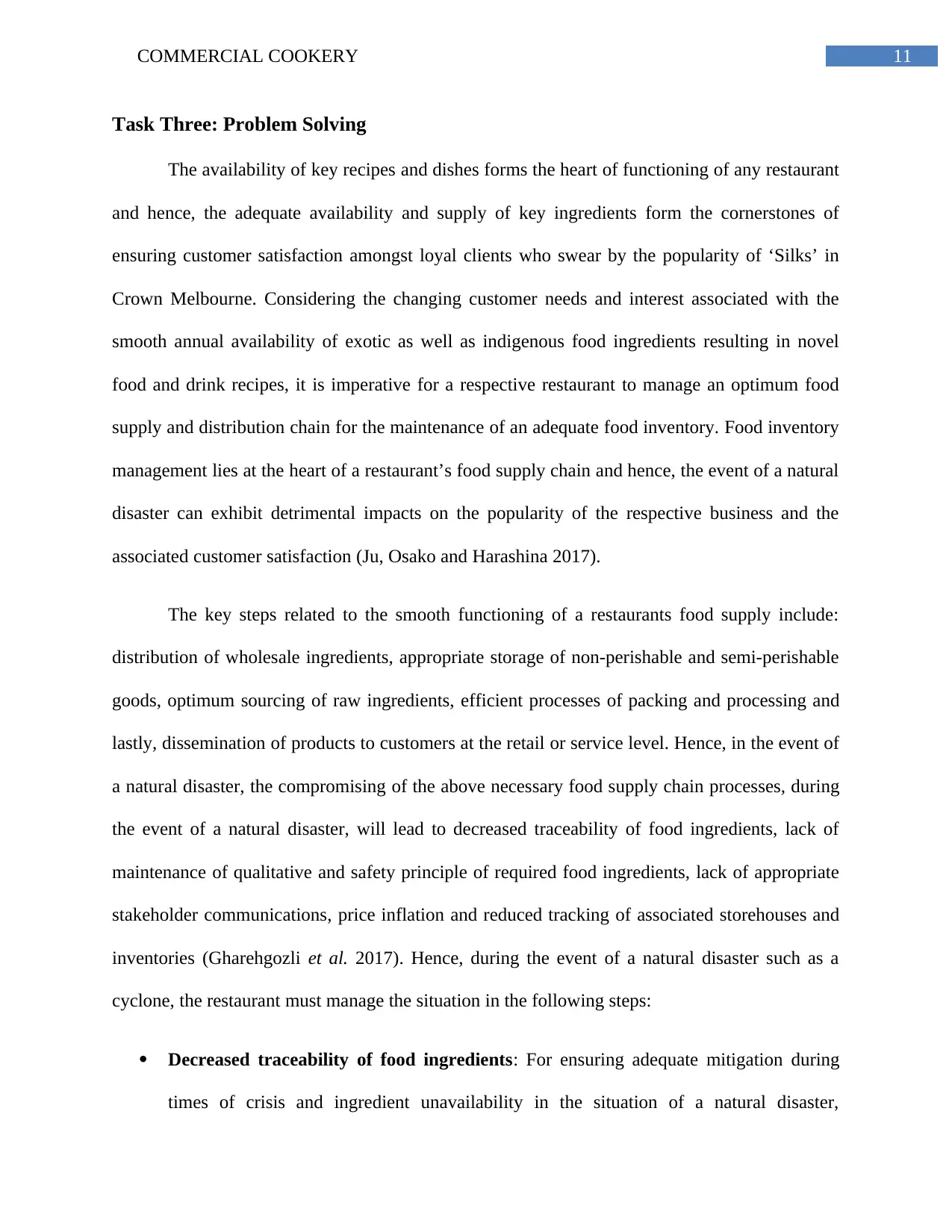
11COMMERCIAL COOKERY
Task Three: Problem Solving
The availability of key recipes and dishes forms the heart of functioning of any restaurant
and hence, the adequate availability and supply of key ingredients form the cornerstones of
ensuring customer satisfaction amongst loyal clients who swear by the popularity of ‘Silks’ in
Crown Melbourne. Considering the changing customer needs and interest associated with the
smooth annual availability of exotic as well as indigenous food ingredients resulting in novel
food and drink recipes, it is imperative for a respective restaurant to manage an optimum food
supply and distribution chain for the maintenance of an adequate food inventory. Food inventory
management lies at the heart of a restaurant’s food supply chain and hence, the event of a natural
disaster can exhibit detrimental impacts on the popularity of the respective business and the
associated customer satisfaction (Ju, Osako and Harashina 2017).
The key steps related to the smooth functioning of a restaurants food supply include:
distribution of wholesale ingredients, appropriate storage of non-perishable and semi-perishable
goods, optimum sourcing of raw ingredients, efficient processes of packing and processing and
lastly, dissemination of products to customers at the retail or service level. Hence, in the event of
a natural disaster, the compromising of the above necessary food supply chain processes, during
the event of a natural disaster, will lead to decreased traceability of food ingredients, lack of
maintenance of qualitative and safety principle of required food ingredients, lack of appropriate
stakeholder communications, price inflation and reduced tracking of associated storehouses and
inventories (Gharehgozli et al. 2017). Hence, during the event of a natural disaster such as a
cyclone, the restaurant must manage the situation in the following steps:
Decreased traceability of food ingredients: For ensuring adequate mitigation during
times of crisis and ingredient unavailability in the situation of a natural disaster,
Task Three: Problem Solving
The availability of key recipes and dishes forms the heart of functioning of any restaurant
and hence, the adequate availability and supply of key ingredients form the cornerstones of
ensuring customer satisfaction amongst loyal clients who swear by the popularity of ‘Silks’ in
Crown Melbourne. Considering the changing customer needs and interest associated with the
smooth annual availability of exotic as well as indigenous food ingredients resulting in novel
food and drink recipes, it is imperative for a respective restaurant to manage an optimum food
supply and distribution chain for the maintenance of an adequate food inventory. Food inventory
management lies at the heart of a restaurant’s food supply chain and hence, the event of a natural
disaster can exhibit detrimental impacts on the popularity of the respective business and the
associated customer satisfaction (Ju, Osako and Harashina 2017).
The key steps related to the smooth functioning of a restaurants food supply include:
distribution of wholesale ingredients, appropriate storage of non-perishable and semi-perishable
goods, optimum sourcing of raw ingredients, efficient processes of packing and processing and
lastly, dissemination of products to customers at the retail or service level. Hence, in the event of
a natural disaster, the compromising of the above necessary food supply chain processes, during
the event of a natural disaster, will lead to decreased traceability of food ingredients, lack of
maintenance of qualitative and safety principle of required food ingredients, lack of appropriate
stakeholder communications, price inflation and reduced tracking of associated storehouses and
inventories (Gharehgozli et al. 2017). Hence, during the event of a natural disaster such as a
cyclone, the restaurant must manage the situation in the following steps:
Decreased traceability of food ingredients: For ensuring adequate mitigation during
times of crisis and ingredient unavailability in the situation of a natural disaster,
⊘ This is a preview!⊘
Do you want full access?
Subscribe today to unlock all pages.

Trusted by 1+ million students worldwide
1 out of 53
Your All-in-One AI-Powered Toolkit for Academic Success.
+13062052269
info@desklib.com
Available 24*7 on WhatsApp / Email
![[object Object]](/_next/static/media/star-bottom.7253800d.svg)
Unlock your academic potential
Copyright © 2020–2025 A2Z Services. All Rights Reserved. Developed and managed by ZUCOL.